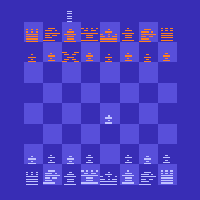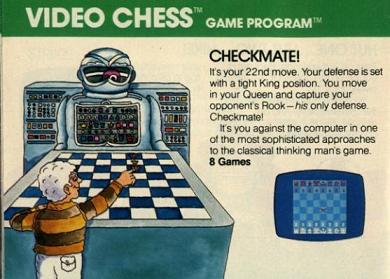Difference between revisions of "Video Chess"
GerdIsenberg (talk | contribs) |
GerdIsenberg (talk | contribs) |
||
| Line 5: | Line 5: | ||
'''Video Chess''',<br/> | '''Video Chess''',<br/> | ||
| − | a chess program for the [[Atari 8-bit|Atari 2600]] [https://en.wikipedia.org/wiki/Video_game_console Video game console] released by [https://en.wikipedia.org/wiki/Atari Atari] in | + | a chess program for the [[Atari 8-bit|Atari 2600]] [https://en.wikipedia.org/wiki/Video_game_console Video game console] released by [https://en.wikipedia.org/wiki/Atari Atari] in 1978, |
developed by [[Larry Wagner]] and [[Bob Whitehead]] (Graphics) in [[6502]] [[Assembly]], the game AI with the help of [[Julio Kaplan]] <ref>[https://www.linkedin.com/in/tekla-perry-33b4a211 Tekla E. Perry], [https://spectrum.ieee.org/at-work/innovation/review-liars-outliers Paul Wallich] ('''1983'''). ''[http://www.atarimuseum.com/videogames/consoles/2600/Atari_case_history.html Design case history: the Atari Video Computer System]''. [[IEEE#Spectrum|IEEE Spectrum]], March 1983, "Doing the 'impossible': chess"</ref>. | developed by [[Larry Wagner]] and [[Bob Whitehead]] (Graphics) in [[6502]] [[Assembly]], the game AI with the help of [[Julio Kaplan]] <ref>[https://www.linkedin.com/in/tekla-perry-33b4a211 Tekla E. Perry], [https://spectrum.ieee.org/at-work/innovation/review-liars-outliers Paul Wallich] ('''1983'''). ''[http://www.atarimuseum.com/videogames/consoles/2600/Atari_case_history.html Design case history: the Atari Video Computer System]''. [[IEEE#Spectrum|IEEE Spectrum]], March 1983, "Doing the 'impossible': chess"</ref>. | ||
According to Larry Wagner, Video Chess was developed as a direct result of a customer who complained that the (original) [https://en.wikipedia.org/wiki/Atari_2600#Launch_and_success Video Computer System] box showed a picture of chess, but that no chess game existed <ref>[http://www.digitpress.com/library/interviews/interview_bob_whitehead.html DP Interviews with Bob Whitehead] by Scott Stilphen</ref>. [https://en.wikipedia.org/wiki/Bank_switching Bank switching] [[Memory#ROM|ROMs]] was pioneered for earlier prototypes of Video Chess that were larger than four kilobytes, however the released version ended up fitting the standard 4K size <ref>[https://en.wikipedia.org/wiki/Video_Chess Video Chess from Wikipedia]</ref>. | According to Larry Wagner, Video Chess was developed as a direct result of a customer who complained that the (original) [https://en.wikipedia.org/wiki/Atari_2600#Launch_and_success Video Computer System] box showed a picture of chess, but that no chess game existed <ref>[http://www.digitpress.com/library/interviews/interview_bob_whitehead.html DP Interviews with Bob Whitehead] by Scott Stilphen</ref>. [https://en.wikipedia.org/wiki/Bank_switching Bank switching] [[Memory#ROM|ROMs]] was pioneered for earlier prototypes of Video Chess that were larger than four kilobytes, however the released version ended up fitting the standard 4K size <ref>[https://en.wikipedia.org/wiki/Video_Chess Video Chess from Wikipedia]</ref>. | ||
| Line 14: | Line 14: | ||
Bob Whitehead developed a pioneering "venetian blinds" <ref>[https://en.wikipedia.org/wiki/Venetian_blinds#Venetian Venetian Blinds from Wikipedia]</ref> animation technique, | Bob Whitehead developed a pioneering "venetian blinds" <ref>[https://en.wikipedia.org/wiki/Venetian_blinds#Venetian Venetian Blinds from Wikipedia]</ref> animation technique, | ||
an algorithm that horizontally reused and vertically interlaced sprites several times while rendering each frame, | an algorithm that horizontally reused and vertically interlaced sprites several times while rendering each frame, | ||
| − | to give the illusion that the system had more than the maximum number of sprites allowed by the hardware <ref>[https://en.wikipedia.org/wiki/Bob_Whitehead Bob Whitehead from Wikipedia]</ref>. | + | to give the illusion that the system had more than the maximum number of sprites allowed by the hardware <ref>[https://en.wikipedia.org/wiki/Bob_Whitehead Bob Whitehead from Wikipedia]</ref>. However, the computer could not show the position and calculate at the same time. |
| + | |||
| + | =Tournament Play= | ||
| + | Two instances of the program played the [[MCC 1980|North American Microcomputer Chess Championship]] 1980 in [https://en.wikipedia.org/wiki/San_Jose,_California San Jose, California], where Atari A gained a respectable 50% score <ref>Bryce Perry ('''1980'''). ''North American Microcomputer Championship''. [http://www.chessdryad.com/articles/chessvoice/index.htm Chess Voice], October - November 1980, [http://www.chessdryad.com/articles/chessvoice/1980cv13_4.pdf pdf], pp. 71</ref>. | ||
=Atari Catalog 1981= | =Atari Catalog 1981= | ||
| Line 42: | Line 45: | ||
'''[[Engines|Up one Level]]''' | '''[[Engines|Up one Level]]''' | ||
[[Category:Chess Suffix]] | [[Category:Chess Suffix]] | ||
| + | [[Category:Console]] | ||
[[Category:Console]] | [[Category:Console]] | ||
Revision as of 11:33, 8 September 2019

Video Chess,
a chess program for the Atari 2600 Video game console released by Atari in 1978,
developed by Larry Wagner and Bob Whitehead (Graphics) in 6502 Assembly, the game AI with the help of Julio Kaplan [2].
According to Larry Wagner, Video Chess was developed as a direct result of a customer who complained that the (original) Video Computer System box showed a picture of chess, but that no chess game existed [3]. Bank switching ROMs was pioneered for earlier prototypes of Video Chess that were larger than four kilobytes, however the released version ended up fitting the standard 4K size [4].
Contents
Venetian Blinds
The up to eight pieces per row exceeded the sprite limitations, since the Atari 2600 was only able to display three sprites in a row. Bob Whitehead developed a pioneering "venetian blinds" [5] animation technique, an algorithm that horizontally reused and vertically interlaced sprites several times while rendering each frame, to give the illusion that the system had more than the maximum number of sprites allowed by the hardware [6]. However, the computer could not show the position and calculate at the same time.
Tournament Play
Two instances of the program played the North American Microcomputer Chess Championship 1980 in San Jose, California, where Atari A gained a respectable 50% score [7].
Atari Catalog 1981
Atari Catalog 1981 Scan, Video Chess [8]
See also
Publications
- John Urwin (1979). Two New Programs Are Tested. Personal Computing, Vol. 3, No. 12, pp. 71 » MyChess
Forum Posts
- Atari 2600 Video Chess by Steven Edwards, Hiarcs Forum, December 29, 2013
External Links
- Video Chess from Wikipedia
- Video Chess for Atari 2600 (1979) - MobyGames
- Video Chess for Atari 2600 (1979) MobyRank - MobyGames
- AtariAge - Atari 2600 - Video Chess (Atari)
- Atari 2600 Manual: Video Chess (1978)(Atari) hosted by the Internet Archive [9]
- MESS in a browser! - Atari 2600: Video Chess hosted by the Internet Archive [10]
References
- ↑ A screenshot of Video Chess (1979), Video Chess from Wikipedia
- ↑ Tekla E. Perry, Paul Wallich (1983). Design case history: the Atari Video Computer System. IEEE Spectrum, March 1983, "Doing the 'impossible': chess"
- ↑ DP Interviews with Bob Whitehead by Scott Stilphen
- ↑ Video Chess from Wikipedia
- ↑ Venetian Blinds from Wikipedia
- ↑ Bob Whitehead from Wikipedia
- ↑ Bryce Perry (1980). North American Microcomputer Championship. Chess Voice, October - November 1980, pdf, pp. 71
- ↑ HuguesJohnson.com: Atari Catalog 1981 Scans
- ↑ Atari 2600 Video Chess by Steven Edwards, Hiarcs Forum, December 29, 2013
- ↑ Multi Emulator Super System - Wikipedia
